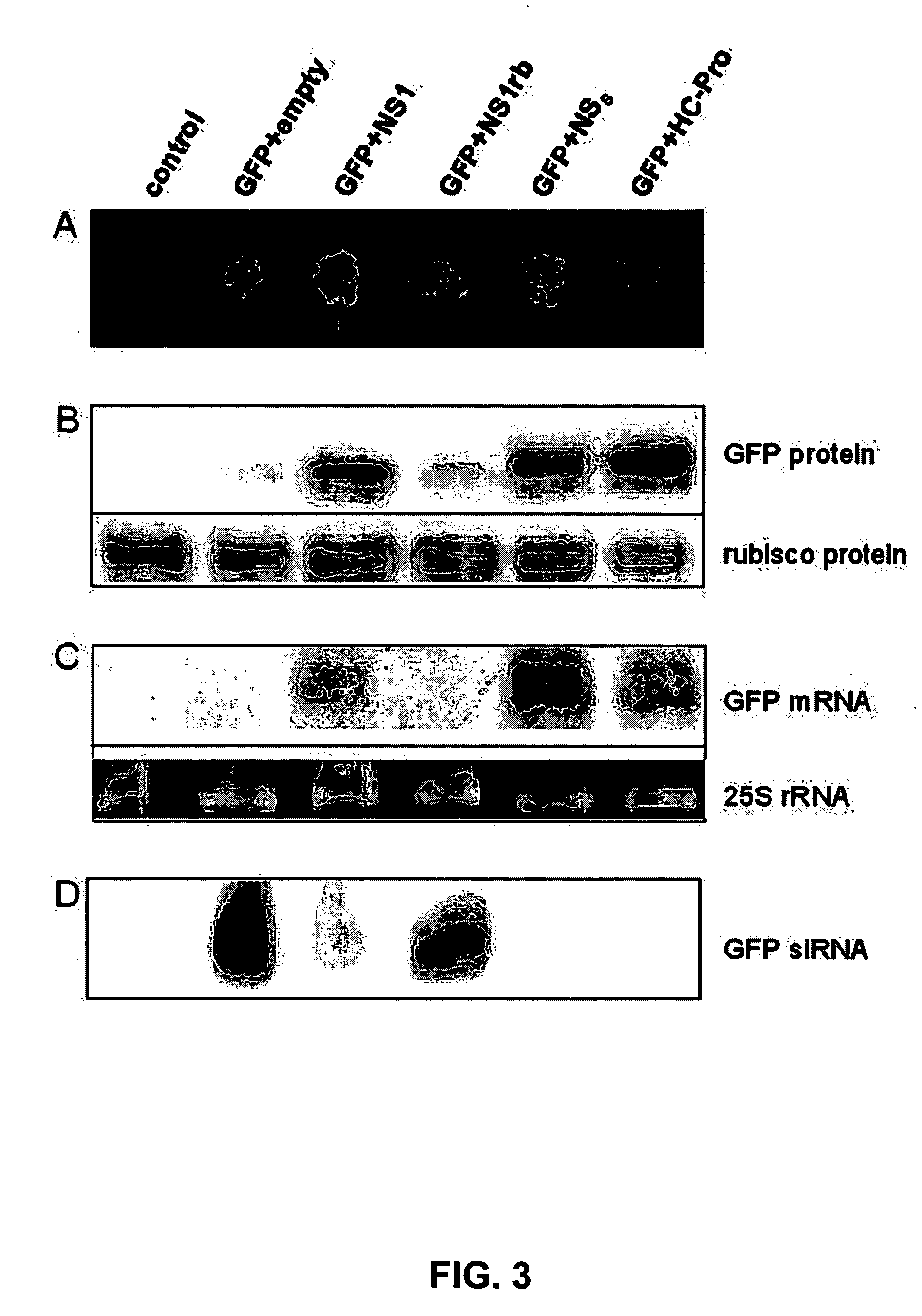Expressional enhancers from viruses
a technology of expression enhancers and viruses, which is applied in the field of virus expression enhancers, can solve the problems of poorly replicating gamma herpes viruses, unable to precisely explain the role of rna silencing, and the inability to easily transform cells
- Summary
- Abstract
- Description
- Claims
- Application Information
AI Technical Summary
Benefits of technology
Problems solved by technology
Method used
Image
Examples
example 1
Methods and Materials
[0097] Plant material & viruses:—Transgenic Nicotiana benthamiana plants were used harboring a GFP transgene expressed from a 35S promoter—NOS terminator expression cassette. Transgenic lines were selected for strong GFP fluorescence prior to self-pollination. Subsequent S1 plants were scored for gene silencing by checking for GFP expressing in meristematic tissues in otherwise non-expressing (silenced) plants. S2 progenies of these plants were homozygous and all showed a silenced phenotype resulting in silenced leaf tissue after several days and complete silencing also in veins and stems after several weeks. These S2 plants were used in a series of inoculation experiments. Tomato spotted wilt virus (TSWV) isolate BR-01, Groundnut ringspot virus (GRSV) isolate SA-05 and Impatiens necrotic spot virus (INSV) isolate NL-07 were inoculated in series on both GFP silenced and non-transgenic N. benthamiana plants acting as controls. For reference, the Potyviruses Pota...
example 2
Agrobacterium T-DNA Transient Expression Assays in N. benthamiana
[0105] The Agrobacterium strains carrying TSWV gene constructs are injected in leaves together with the strain carrying pBIN-GFP. The GFP expression is monitored during the following days and photographed 6 days after injection (FIG. 1). Only co-infiltration of pBIN-GFP with pBIN-TSWV-NSS gene leads to an increase of the GFP fluorescence in the injected leaf areas (FIG. 1D). Co-infiltration of pBIN-GFP with the other TSWV gene constructs does not lead to an increase of the GFP fluorescence in the injected leaf areas (FIGS. 1A, B, C).
[0106] Co-infiltration of pBIN-GFP with pBIN-RHBV-NS3, pBIN-IVA-NS1 or pBIN-CABMV-HCPro also leads to an increase in the GFP, which is much stronger than that obtained with pBIN-CMV-2b (FIGS. 2 and 3A).
example 3
Influenza Virus A NS1 Binds siRNAs and Protects GFP mRNAs from Degradation
[0107]Nicotiana benthamiana leaves are co-infiltrated with the Agrobacterium strain harboring pBIN-GFP and those harboring pBIN-IVA-NS1, pBIN-IVA-NS1rb, pBIN-TSWV-NSs or pBIN-CABMV-HCPro (FIG. 3A). The amount of GFP accumulating in the infiltrated leaf sectors is determined using quantitative Western blot analysis. Total protein is extracted from infiltrated leaf sectors and resolved using denaturating polyacrylamide gel electrophoresis. The proteins are blotted to nitrocellulose and the ribulose 1,5 bi-phosphate carboxylase (rubisco) protein abundance on the blots is visualized using anti-rubisco antibodies and used as a loading control. The amounts of expressed GFP is visualized using anti-GFP antibodies. The amounts of GFP accumulating in cells which also express TSWV NSs, CABMV HC-Pro or WVA NS1 are significantly higher than those in cells which also express the pBIN19 empty vector or pBIN-WVA-NS1rb (FIG....
PUM
| Property | Measurement | Unit |
|---|---|---|
| pH | aaaaa | aaaaa |
| exposure time | aaaaa | aaaaa |
| exposure time | aaaaa | aaaaa |
Abstract
Description
Claims
Application Information
 Login to View More
Login to View More - R&D
- Intellectual Property
- Life Sciences
- Materials
- Tech Scout
- Unparalleled Data Quality
- Higher Quality Content
- 60% Fewer Hallucinations
Browse by: Latest US Patents, China's latest patents, Technical Efficacy Thesaurus, Application Domain, Technology Topic, Popular Technical Reports.
© 2025 PatSnap. All rights reserved.Legal|Privacy policy|Modern Slavery Act Transparency Statement|Sitemap|About US| Contact US: help@patsnap.com



